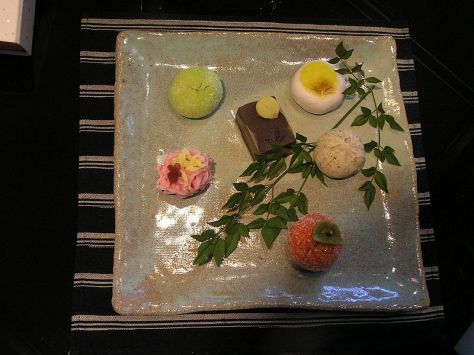
There is a traditional way of making cakes in Japan that ought to please no end vegans and people allergic to wheat flour and dairy products, namely Wagashi!
Wagashi (和菓子) is a traditional Japanese confectionery which is often served with tea, especially the types made of mochi, azuki bean paste, and fruits.
Wagashi is typically made from natural based (mainly plant) ingredients. The names used for wagashi commonly fit a formula—a natural beauty and a word from ancient literature; they are thus often written with hyōgaiji (kanji that are not commonly used or known), and are glossed with furigana.
Generally, confectioneries that were introduced from the West after the Meiji Restoration (1868) are not considered wagashi. Most sorts of Okinawan confectionery and those originating in Europe or China that use ingredients alien to traditional Japanese cuisine, e.g., kasutera, are only rarely referred to as wagashi.

Assortment of wagashi for a tea ceremony
During the Edo period, the production of sugarcane in Okinawa became highly productive, and low quality brown sugar as well as heavily processed white sugar became widely available. A type of sugar, wasanbon, was perfected in this period and is still used exclusively to make wagashi. Wagashi was a popular gift between samurai, in significance much like a good wine. Wagashi is served as part of a Japanese tea ceremony, and serving a good seasonal wagashi shows one’s educational background.

Wagashi in the shape of rape flowers/Na no Hana
There are many, many kinds of Wagashi.
I will introduce them in the next posting, followed by another posting on the basic preparation.

Shizuoka’s Abekawa Mochi
Just know that about every region in Japan has its own traditional Wagashi!
Avaibility:
Wagashi is widely available in Japan, but quite rare outside it.
Minamoto Kitchoan (源 吉兆庵)
Has a varied selection, and stores in New York City (shipping throughout the US), London (shipping throughout Europe), and Singapore, in addition to Japan.
Toraya (とらや)
Has a full Paris store, stores in Japan, and sells a limited selection (yōkan only) at New York stores.
Fugetsu-do
Family owned and operated in the USA, since 1903, Fugetsu-do now ships anywhere in the USA.
Please check the new postings at:
sake, shochu and sushi
—————————————-
日本語のブログ
—————————————-
This is wonderful stuff! Mochi is gluten free.. Never would have thought of that!
LikeLike
Dear Friend!
Greetings!
I will post a simple recipe on mochi soon!
Cheers,
Robert-Gilles
LikeLike
The Abekawa Mochi looks like a Zen Garden, no? I think I could eat until I crawl from all these wagashi!
LikeLike
Dear Pixen!
Wait until i come with all kinds of pics!
LOL
Cheers,
Robert-Gilles
LikeLike
Bonjour Robert,
Love the article, they are so pretty. I can’t wait for the recipes all dough I’m afraid they will never look that good coming out of my hands.
Laura
LikeLike
Bonjour, Laura!
The next article will appear today, featuring the first easy recipe!
Cheers,
Robert-Gilles
LikeLike
This actually sounds like something I could eat. But sometimes I hate when the presentation is so beautiful because I hate to destroy it… but I’m sure that once I tasted that goodness I would get over it! 🙂
LikeLike
Lol!
Dear Tericita!
If you worry too much about ruining the cake, you’ll never eat it!
Cheers,
Robert-Gilles
LikeLike
Interesting stuff. My wife, also a foodie, has recently determined she is allergic to wheat, dairy and probably other things, so these might be of interest to/for her. I so, that will be an eye-opener for her as she thinks of Japanese food only in terms of sushi. I look forward to recipes.
LikeLike
Dear Lorenzo!
Greetings!
I will eventually run an article on an easy recipe.
The Missus will be able to discover an interesting food.
Incidentally, I have also run an article on vegan sushi. It’s on Pages on the right!
Cheers,
Robert-Gilles
LikeLike
The presentation of them is just amazing. It’s almost too good to eat. Almost.
LikeLike
Dear Jenn!
This is a specialty with a very long history!
It’s considered as an art of its own in Japan!
Cheers,
Robert-Gilles
LikeLike
These are adorable cakes! I love all the bright colors!
LikeLike
Dear Natasha!
Wait until I come up with the different varieties!
LOL
Robert-Gilles
LikeLike
Wow, they’re works of art! Thanks for sharing!
LikeLike
Dear Lou-Ann!
Greetings!
More coming soon!
Cheers,
Robert-Gilles
LikeLike